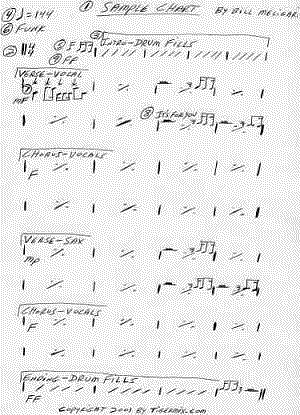Homemade Drum Charts
Last week's feature dealt with two important topics: Developing your ear training and writing your own drum charts. (If you missed it, take a look at Chart and Listen in the Related Links sidebar.)
This week I show you an example of how I would create a "homemade" drum chart. I've also included a blank Drum Chart Template that you can download and use as a guide when writing your own. Enjoy!
Sample Chart

Click Here for a full size version of the above Sample Chart
I created the above sample chart so all examples would fit onto a single page. It doesn't represent an actual song. The circled numbers that appear on the chart are included only to correspond with the numbered explanations that follow (you wouldn't include these numbers on your charts).
To keep things simple, I based the chart on the standard verse/chorus song form. (If you'd like an explanation of song forms, check out the Related Links on the Web sidebar.)
Rolling Your Own
You can use music paper for your chart, plain blank paper (as I did in my sloppy example), or do it the easy
way - download and print my blank Drum Chart Template.
Whatever you decide to do, just be sure to make a copy of your original and keep it in a safe place, for
emergencies. Also, be sure to work in pencil. The chart will most likely change numerous times before it's
cast in stone.
Let's go over the sample chart above, by the numbers:
- Title your chart and keep your charts all in one place. Alphabetic order will allow quick access on the gig.
- Sketch out the number of measures in the song and include the time signature. (If you don't know what a time signature is, refer to my Tiger Reading series in the Related Links sidebar.)
- Identify any Intro, Ending, Verse, Chorus, Bridge, or Solo sections in the song. Include the featured instrument or vocal designation in each section.
- Once you have settled on the correct tempo for the song, include it on your chart.
- Write out any figures that you will need to "cut" with the band.
- Mark down the musical style of the song.
- Write your detailed drum pattern in (at least) one measure of the chart.
- If there are any lyrics that set up an important accented figure, add them. If you get lost while playing the chart, this will help you find your place.
- Include all dynamics on the chart. You can use the legitimate dynamic markings, as shown, or make up your own.
Chart it, You'll Like It!
Even if you don't use your drum charts on the actual gig, I highly recommend creating them anyway. The process
of writing helps you memorize the song faster and retain it longer than simply picking it up by ear - unless
you're lucky enough to have been born with a photo-music memory like Buddy Rich!
Until next time: Stay loose.
